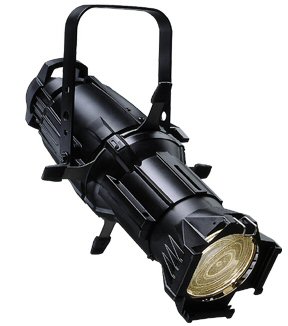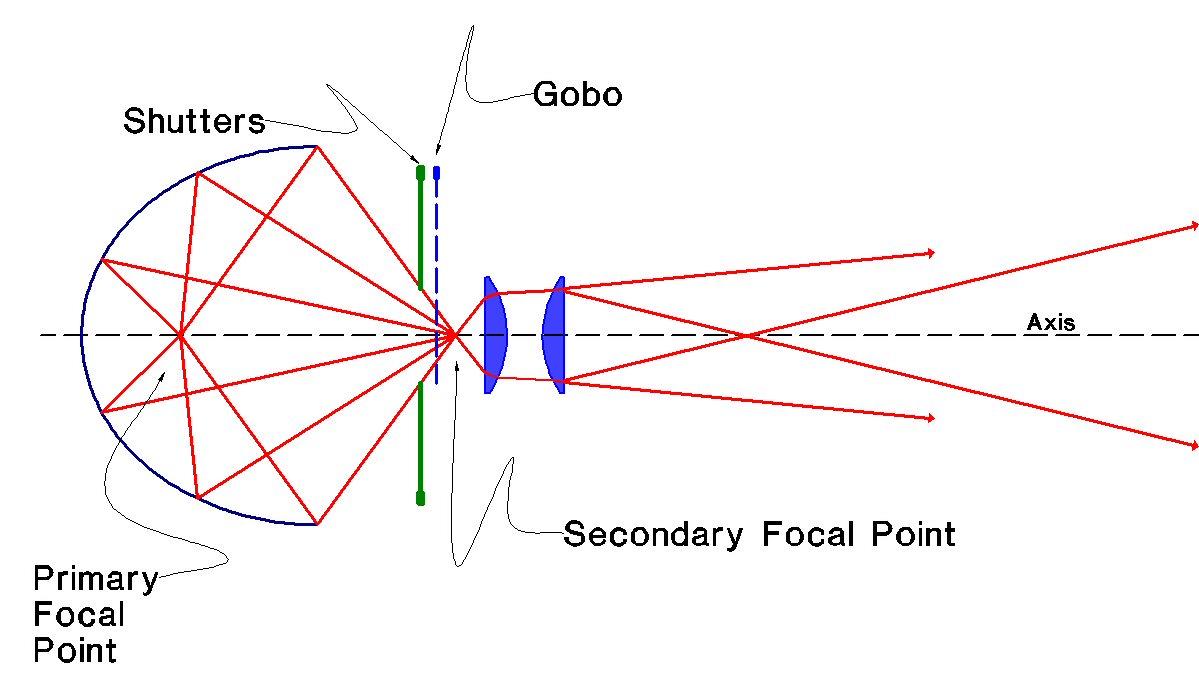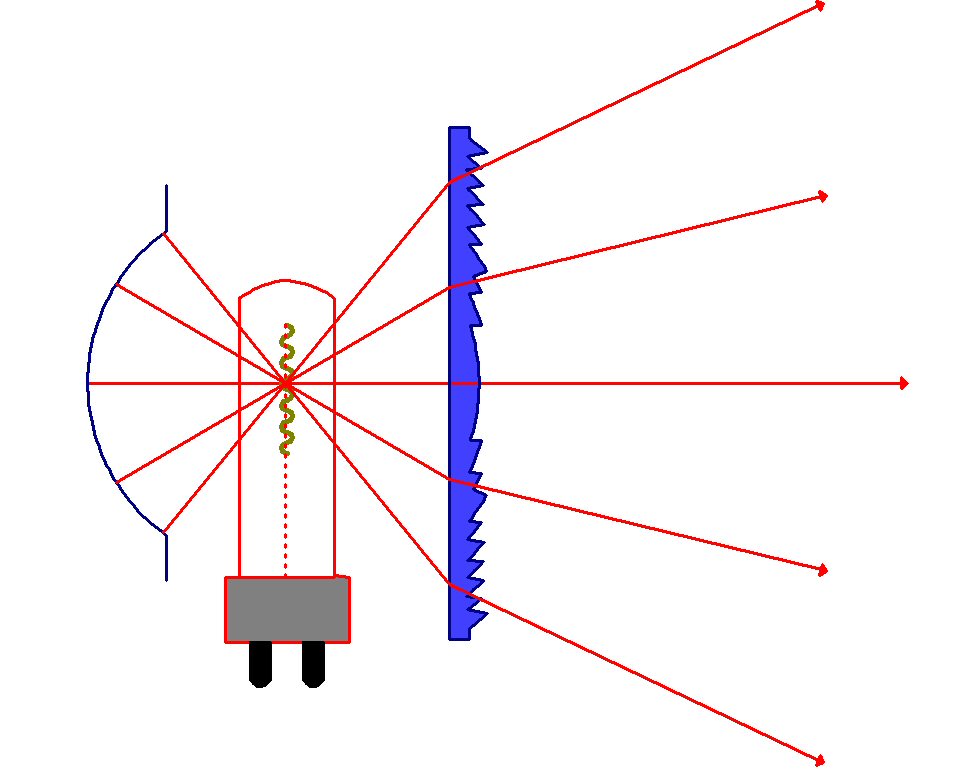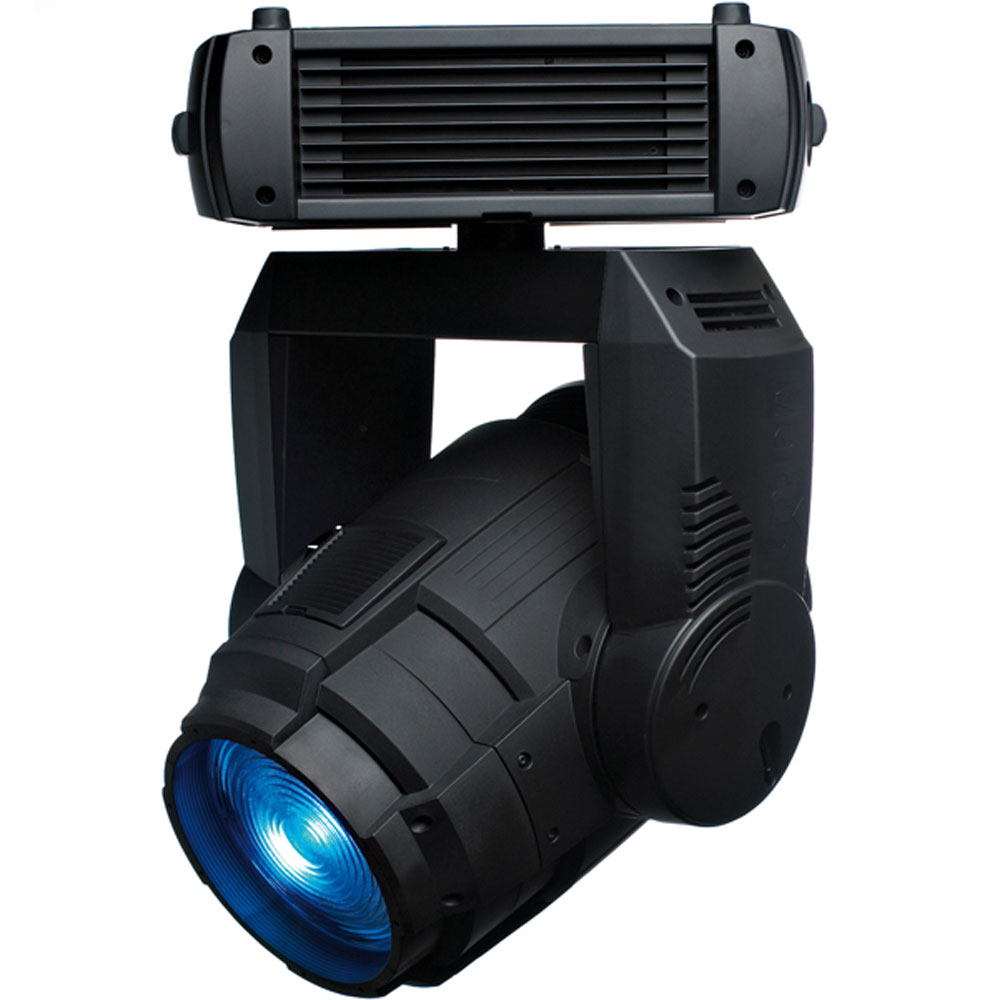Ellipsoidal Reflector Spotlight



|
The ellipsoidal reflector spotlight combines an ellipsoidal
reflector usually with either one step lens or two plano-convex lenses
"belly-to-belly". In America, these fixtures are often referred to as
"Lekos", but that is actually the trade name of those ERSes
manufactured originally by Century and subsequently by Strand.
In the UK, they are referred to as "profile spots".
 Because the focal point of the lens system is just in front of
the aperture (or gate), an image of anything placed in the
gate will be projected by the lenses. Because the optics invert the projected image, it will
appear to be upside down and backwards. Or maybe it's already upside
down and backwards, and the optics turn it right-side up. That's for you to decide.
ERSes typically have four framing shutters, which are used to
shape the beam of light. Because the projected image is
inverted, pushing in the left shutter will cut off the right
side of the beam, pushing in the top shutter will cut off the
bottom of the beam, etc. A pattern inserted in the gate is
called a "template" or "gobo". Since the image is inverted,
gobos must be inserted into the fixture upside down and
backward.
ERSes are useful when you want:
Because the focal point of the lens system is just in front of
the aperture (or gate), an image of anything placed in the
gate will be projected by the lenses. Because the optics invert the projected image, it will
appear to be upside down and backwards. Or maybe it's already upside
down and backwards, and the optics turn it right-side up. That's for you to decide.
ERSes typically have four framing shutters, which are used to
shape the beam of light. Because the projected image is
inverted, pushing in the left shutter will cut off the right
side of the beam, pushing in the top shutter will cut off the
bottom of the beam, etc. A pattern inserted in the gate is
called a "template" or "gobo". Since the image is inverted,
gobos must be inserted into the fixture upside down and
backward.
ERSes are useful when you want:
- A sharp edge,
- A fixture which can be shuttered off scenery,
- A fixture which can project a pattern, and/or
- High intensity.
ERSes are typically available in fixed focal lengths, although zooms are available.
"Fixed focal length" means that you can not significantly change the size of the beam other than by moving
the fixture nearer or farther, shuttering it, or using a gobo.
ERSes are usually described in one of two ways:
- By the lens(es) used in the fixture ("6x9", "6x12", etc.), or
- By their approximate field angle (40º, 19º, etc.)

Early ERSes had the lamp housing mounted at a 45° angle to
the axis of the reflector and lens train. Since this puts
the lamp on a radius of the primary focal point, these
fixtures are referred to as radial ERSes.

|

|
More modern ERSes have the lamp on the axis of the
optical system. These fixtures are referred to as
axial fixtures.

|

|
|
If the lamp of an ERS is out of alignment — not
precisely at the primary focal point of the reflector --
the fixture's efficiency and the evenness of the field
are seriously impaired.
|
|
Fresnel Lens Spotlight


|
Fresnel-lensed spotlights are usually lighter and smaller than ERSes. Fresnels have variable
beam widths. Moving the lamp closer to the lens makes the field
wider; moving the lamp away from the lens makes the field
smaller. Their widest beams are wider than the beams from all
but the widest of ERSes. The light from a Fresnel is
very soft. The beam can be shaped by external "barndoors",
but cannot be cut as sharply as can the beams of ERSes.
There are no internal shutters; gobos are not useable with Fresnels.
Some Fresnels have oval beams.
Some Fresnels control the spot/flood setting with a sliding screw on the bottom of the
fixture; others use a crank.
Traditional Fresnels use spherical reflectors. Electronic
Theatre Controls' Source 4® PARnel, while designed
as a replacement for the Fresnel-lensed spotlight, has a
different type of lens and reflector.
Fresnels are useful when you want:
- A soft edge, or
- The ability to vary the field width


|
Plano-Convex Spotlights

|
Plano-Convex spotlights use a spherical reflector and a
plano-convex lens. As with a Fresnel, changing the distance
between the lamp and the lens changes the width of the field,
but a PC spot produces a sharp-edged field; in fact, the only physical
difference between a Fresnel and a PC spot is the lens. The light from PC spots
is somewhat less soft than that from Fresnels.
In America, PC spots have long been considered to be obsolete, but their
use is very common in Europe and there is some evidence that they may be regaining popularity
once more in the United States.
A common variant of the PC spot exists called "pebble convex"
or "prism convex" in which the lens is stippled to give a
less defined beam, somewhat less diffused than that of a Fresnel,
but still significantly softer than that of an ERS.
|
Parabolic Aluminized Reflector



|
 The traditional PAR fixture is self-contained; the lamp,
parabolic reflector, and lens are combined in one unit and the instrument
itself is little more than a can holding the lamp. To change
field size, you change the lamp. Typical field sizes are:
The traditional PAR fixture is self-contained; the lamp,
parabolic reflector, and lens are combined in one unit and the instrument
itself is little more than a can holding the lamp. To change
field size, you change the lamp. Typical field sizes are:
- Very Narrow Spot (VNSP)
- Narrow Spot (NSP)
- Medium Flood (MFL)
- Wide Flood (WFL)
PAR lamps are identified by their diameters, in eighths of an
inch; a PAR64, therefore, is 8" wide (because 64 eighths of an
inch is 8"). Most of the larger PAR (PAR56 and PAR64) medium flood and wide flood lamps
have oval beams.
 Recent products by Electronic Theatre Controls and Altman have
separate lamps and reflectors with interchangeable lenses; in
addition to the above field sizes, these newer fixtures have
Extra Wide Flood (XWFL) lenses, which produce round fields.
The MR16 and MR20 are 2" and 2-½" units (respectively) using
dichroic parabolic
Recent products by Electronic Theatre Controls and Altman have
separate lamps and reflectors with interchangeable lenses; in
addition to the above field sizes, these newer fixtures have
Extra Wide Flood (XWFL) lenses, which produce round fields.
The MR16 and MR20 are 2" and 2-½" units (respectively) using
dichroic parabolic
 reflectors but (usually) no lens and are often used for display
work and for mounting in or on scenic units. In the US & UK, they're
referred to as "birdies"...because they're "under PAR".
reflectors but (usually) no lens and are often used for display
work and for mounting in or on scenic units. In the US & UK, they're
referred to as "birdies"...because they're "under PAR".
|
LED Fixtures

|
Dimmable color-mixing fixtures using Light-Emitting Diodes
represent a fairly new theatre technology. While in theory,
they allow the designer to mix any conceiveable color, in
practice this is limited by several factors, including the
purity of the color produced by the LEDS as well as their
relative lack of intensity.
Various manufacturers have chosen different approaches to the
design of these fixtures; some use only the three primary
colors, while others have as many as 7 different colors of LEDs
in each fixture.
LEDs are extremely efficient; one could conceiveably run an
entire show from 2 or 3 wall outlets. They produce relatively
little heat, as compared to conventional fixtures.
LED fixtures are manufactured as wide-dispersal, "wall-wash"
type architectural fixtures or as a more controllable, PAR-like
instrument. The Altman SpectraPAR TM
(as well as certain products by other manufacturers) is available in
the same field sizes as conventional PAR64s. Recently, we have seen
LED fixtures capable of projecting a hard-edged beam. These mimic
the performance of ellipsoidal reflector spotlights, complete with
shutter cuts and the ability to project gobos.
Increasingly, LED fixtures are being manufactured so as to generate
"white" (with either a "daylight" or a "tungsten" color balance)
light. While these still require color filters, the gels, due to
the much lower operating temperatures, do not burn out, and the
fixtures require much less electricity to operate, as well as
dramatically lowering the cost of air conditioning.
|
Svoboda

|
The Svoboda is named for legendary designer Josef Svoboda, who
was searching for a way to create dramatic scenic effects using
only light. The Svoboda batten consists of 9 or 10 lamps and
produces a very bright, almost-parallel field. They are rarely
seen in the US, but are much more common in Europe.
|
Linnebach Projector

|
A Linnebach projector is a lensless projection system with a transparent
slide place at the end of a long body, with a lamp at the other end.
Provides soft, impressionistic images. Rarely used today, the Linnebach
can be quite effective in the proper situation.
|
Scoops and other Floodlights


|
Floodlights produce a very soft, very wide field, typically without
lenses. Specialized
floodlights combining two or more compartments in one fixture
are known as cyc lights, as they are usually used to light
cycloramas and other backdrops.
|
Striplights


|
Striplights (also known as borderlights) are compartmented fixtures designed for use as a
general wash of light, usually on cycloramas or backdrops.
They are usually available wired for either three or four
circuit operation with multiple lamps per circuit.
Striplights can use both gel and glass roundels.
|
Followspots

|
Followspots are fixtures designed to be manually operated, allowing
the electrician to light a performer, with an intense, controllable beam,
around the stage. A professional-quality followspot will have a iris
for controlling the size of the beam, a dowser (a mechanical dimmer
which allows the operator to control the intensity and to fade in
and fade out the light), and a color boomerang, which allows the
operator to change the color of the beam.
Followspots should be bright enough to "cut through" the existing
stage lighting. Often, theatres have purchased followspots
which are too weak for the required throw; in these cases, the
designer is better off using an ellipsoidal reflector spotlight with
an iris installed.
|
Automated Fixtures


|
While a detailed description of moving lights and other automatic
fixtures would be too technical for beginning lighting design
students, below is an overview of the most commonly-seen features:
- Moving Head (or Moving Yoke): These units
work by moving the entire fixture body. Moving yoke fixtures
may be "spot" fixtures, which are more tightly controlled, or
"wash" fixtures, which are designed to cover (usually using
several fixtures) a large area.
- Moving Mirror (or Scanner): The fixture body
is stationary and the light is reflected by a mirror, which
redirects the light by panning and tilting.
Most automated fixtures have several features which can be
manipulated to create various effects. The most common of
these are:
- Pan: The movement of the field from side to side.
Many fixtures have two Pan channels: one for coarse movement
and one for finer, more precise, settings.
- Tilt: The movement of the field up and down. Again,
many fixtures have two Tilt channels.
- Color: Automated fixtures can change colors in
either of two ways:
- With dichroic filters mounted on a color wheel.
The user can select only one of these colors at a time.
These colors may (or may not) be replaceable.
- With dichroic filters in the secondary colors --
Cyan, Yellow, and Magenta. These can be subtractively
mixed incrementally to create an infinite palette.
- Iris and/or Zoom: used to vary the diameter
of the beam
- Gobo: Mounted on a wheel. Some fixtures have more
than one gobo wheel, allowing the user to overlap two gobos.
Some of these gobos may be continuously rotatable.
- Intensity: May be controlled electronically,
in the case of fixtures using incandescent lamps, or
mechanically, in the case of fixtures using gas-discharge
lamps.
- Shutter: Used to "strobe" the beam. The term can also
refer to automated shutters that work like the manual shutters
on an ellipsoidal reflector spotlight.
Other features which are found on many moving lights include prisms,
distorted glass, and motor speeds.
Several companies make accessories which are designed to add
moving-light functionality to conventional, static, fixtures.
 These
include moving mirrors and automated irises. These
include moving mirrors and automated irises.
|
|